 American Honda recently threw a coming out party for the all-new VTR1000F Super Hawk, inviting the U.S. moto-press to the bash. The event's backdrop was the picturesque wine country of Temecula, California, and its maze of gnarly, tight and twisting back roads proved the perfect venue to show off, as one Honda engineer put it, the Super Hawk's "lively personality." And lively it is, too. With the VTR, Honda feels they've "grabbed the essence of what Americans want in a big, sporting V-twin. The distinctive sound and feel that makes a V-twin seem alive." A spokesman for Honda's R&D department said their target for the Super Hawk was light weight, light steering, and strong low- to mid-range power and torque. Sound like a certain lusty Italian bike we know?
American Honda recently threw a coming out party for the all-new VTR1000F Super Hawk, inviting the U.S. moto-press to the bash. The event's backdrop was the picturesque wine country of Temecula, California, and its maze of gnarly, tight and twisting back roads proved the perfect venue to show off, as one Honda engineer put it, the Super Hawk's "lively personality." And lively it is, too. With the VTR, Honda feels they've "grabbed the essence of what Americans want in a big, sporting V-twin. The distinctive sound and feel that makes a V-twin seem alive." A spokesman for Honda's R&D department said their target for the Super Hawk was light weight, light steering, and strong low- to mid-range power and torque. Sound like a certain lusty Italian bike we know?
Our first impression was that the VTR seemed easier to ride fast than a 916, but soon realized this was not a race replica. Indeed, Honda claims the Super Hawk was never intended as a racing platform. Rather, they deemed it more of a real-world, all-around sporting motorcycle like Honda's own VFR750, but with the robust power delivery only a large displacement V-twin can provide.
Honda admitted to being caught off guard by Suzuki's introduction of their TL1000 90-degree V-twin, and were even more surprised by their rapid release of the bike to dealers. Honda quickly moved the Super Hawk's press launch up by several weeks, and production is set to hit dealers by April.

Honda brought along two members of the VTR's family tree - the Hawk 650 and VR980 prototype.

Many of the design features seen in the VR prototype were carried over to the production VTR, most notably the half fairing, fuel tank and seat section. But many aspects of Super Hawk were not on the prototype. Side-mounted radiators, truss-type frame, engine-mounted swingarm, and even the small chin fairing are all unique to the production bike.
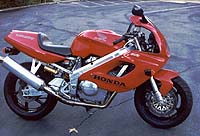
According to Honda engineers the Super Hawk's frame went through six major redesigns.The Super Hawk's unusual frame design contributes greatly to helping meet Honda's original design goals of light weight and responsive steering.
Honda engineers described the VTR's chassis as being "lively" and fine tuned, with six strategically-placed mounting points for an engine that also acts as a stressed member for increased rigidity and lighter weight. Centralized engine placement combines with a slightly tall caster angle to help keep front-end handling light.

The Super Hawk engine displaces 996cc and features almost identical, 180 degree reversed cylinders and heads. 98 x 66mm bore/stroke is identical to that of Suzuki's new TL1000S. Six-speed gearbox is located directly below rear cylinder.
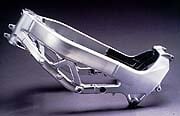
"Rods are carburized to allow them to be slimmer and lighter while maintaining strength."

We found throttle response to be sharp and linear, with no flat spots. Huge carbs exact a fuel consumption penalty, though, and the small 4-gallon tank hits reserve after just 100 or so miles of spirited riding. We netted a best of 32.4 mpg.
The side-mounted dual radiators of the Super Hawk produce the same cooling area as a single front-mounted radiator, but according to Honda engineers the VTR does not have the "dead spots" you find in a radiator mounted in the traditional location behind the front forks, which can result in as much as a 20 percent loss of cooling efficiency.
The VTR's design utilizes the low pressure created by wind passing over the outer surface of the fairing to draw air through from the high pressure zone inside. At low speeds, a large right-side fan blows air over that radiator for cooling.
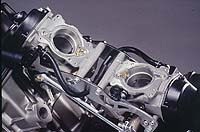 | 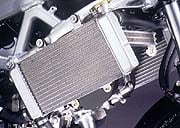 | 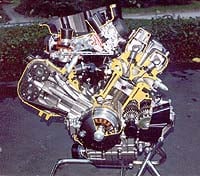 |
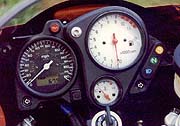 | 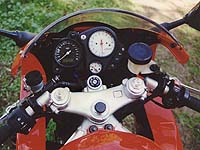 |  |
Even the clutch master cylinder reservoir receives the lighter-is-better treatment, being made from plastic rather than a heavier aluminum casting. Note spring preload and ten-position rebound damping adjusters on top of fork. Dual floating 296mm front discs are clamped by four-piston Nissin calipers similar to those used on the RC45 road bike. Coupled with engine braking from the hearty V-twin motor, stopping power is most impressive.
"VTR really shines in the broad spread of power available from its torquey motor."
 We didn't get to spend much time with the VTR1000, but an afternoon of circling Willow Springs Raceway's 2.5-mile road course lead us to the conclusion that Honda is correct -- this is not a track-oriented design. "Honda personnel may have described this bike as having a lively personality," said Associate Editor Gord Mounce after a short track session on the VTR. "But like a blind date with a 'great personality' you don't want to take her dancing." Suspension rates that performed so well on the backroads were too soft for racetrack duty.
We didn't get to spend much time with the VTR1000, but an afternoon of circling Willow Springs Raceway's 2.5-mile road course lead us to the conclusion that Honda is correct -- this is not a track-oriented design. "Honda personnel may have described this bike as having a lively personality," said Associate Editor Gord Mounce after a short track session on the VTR. "But like a blind date with a 'great personality' you don't want to take her dancing." Suspension rates that performed so well on the backroads were too soft for racetrack duty. In the VTR's defense we didn't have time to change springs or oil, which would have helped. A bigger hurdle for those thinking of racing VTRs is the lack of ground clearance. Rearset pegs and a tighter exhaust pipe will be necessary purchases.
 Where the VTR really shines is in the broad spread of power available from its torquey motor. Speed is deceiving on Honda's V-twin because power builds steadily with no major peaks or valleys. Such a wide powerband allows strong corner exits, with less sliding of the rear tire than on an inline four with its peaky power. Although the VTR felt slow on the straights due to this flat power curve, we found ourselves smoking by 600s on Willow's front straight.
Where the VTR really shines is in the broad spread of power available from its torquey motor. Speed is deceiving on Honda's V-twin because power builds steadily with no major peaks or valleys. Such a wide powerband allows strong corner exits, with less sliding of the rear tire than on an inline four with its peaky power. Although the VTR felt slow on the straights due to this flat power curve, we found ourselves smoking by 600s on Willow's front straight.We certainly plan on getting the Super Hawk back for a longer, more involved test soon. Only next time we hope to also have Suzuki's TL1000S, and maybe even a Ducati 916 thrown in for good measure (and what a yardstick to measure by...). Watch for the ultimate sporting twin-cylinder performance battle next month in Motorcycle Online. Stand back and let the competition begin!



 2:12 AM
2:12 AM
 Unknown
Unknown

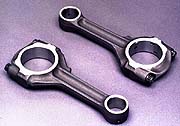
 Posted in:
Posted in: 




0 comments:
Post a Comment